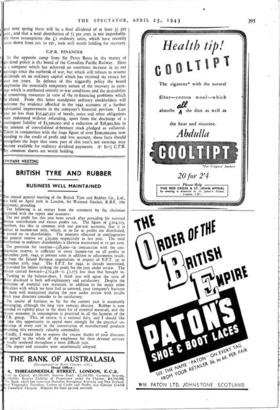FINANCE AND INVESTMENT
By CUSTOS
WITH the Budget hurdle safely behind them, markets have got ba quickly into an easy stride. The pace is no longer hot, but priee as a whole move steadily upward, and, what is more, the rise give every indication of having plenty of staying power. In contrast wi this improvement in the so-called speculative groups there has bee some selling of long-dated gilt-edged stocks, despite Sir Kingsle Wood's reaffirmation of official faith in cheap money as a post-wa as well as a war-time desideratum. The explanation, it seems, that some holders whose duty it is to keep at least half an eye o post-war contingencies have latterly been taking the opportunit to get into a more liquid position. Many industrial firms and larg private capitalists who were content to have a substantial holdin of long-dated stocks, so long as there was little prospect of an earl peace, have been switching into short-dated issues, Treasury Bill or cash. This seems to me to be merely commercial prudence. I need not be interpreted as an indication that the war is about end or that, if that should happen, there would be any serious f in long-dated gilt-edged prices. Meantime, markets as a whole ar behaving well, especially home rails and diamond shares. Althou there must be pauses after the recent rise, I see no reason wh home rail junior stocks such as L.M.S. ordinary and L.N.E. secon preference should not be held for higher lures. Yields are still t high in relation to the average return obtainable on second-clan industrials.
CUNARD DIVIDEND OUTLOOK
The latest accounts of the Cunard Steam Ship Company, stri of the balance-sheet of the Cunard White Star, arc like Haml without the Prince. While it is not difficult to justify the withdra of the report of this important subsidiary, it is no longer possib to assess either the earnings or the assets position of the paren Last year's profits were up from £229,705 to £343,723, but mo than double the year's earnings was paid out in clearing off t heavy arrears of preference dividend. In conequence, the carry forward has been reduced from £578,339 to £220,853, and ho that something like 6 per cent. might be forthcoming on the ordina stock on account of last year's operations have gone unfulfille Holders of the ordinary stock will feel heartened, however, by th board's decision to pay an interim of 21 per cent, in respect the current year. What the total distribution will be can only guessed. In his statement Sir Percy Bates reminds stockholders ill Cunard ordinary is essentially a speculative investment. He reasonably confident, however, in the immediate outlook, and, l judge from his pronouncements on former occasions, he believes giving the risk-bearers of industry a fair return on their mone My guess would be that if things go reasonably well between no and next spring there will be a final dividend of at least 34 per mat., and that a total distribution of 74 per cent. is not improbable. On these assumptions the £x ordinary units, which have recently come down from 2IS. to 19s., look well worth holding for recovery.
C .P .R . FINANCES In the opposite camp from Sir Percy Bates in the matter of *vidend policy is th.; board of the Canadian Pacific Railway. Here is a company which has achieved an enormous increase in its net earnings since the outbreak of war, but which still refuses to resume dividends on an ordinary capital which has received no return for over ten years. In defence of this niggardly policy the board emphasise the essentially temporary nature of the recovery in earn- ings which is attributed entirely to war conditions and the desirability of conserving resources in view of the re-financing problems which e ahead. From this latter standpoint ordinary stockholders will welcome the evidence afforded in the 1942 accounts of a further substantial improvement in the company's financial position: Last ear no less than $35,447,221 of bonds, notes and other obligations were redeemed without refunding, apart from the discharge of a contingent liability of $3,500,000 and a reduction of $28,901,800 in the amount of consolidated debenture stock pledged as collateral. Taken in conjunction with the huge figure of over $200,000,000 now
sanding to the credit of profit and loss account, these facts should srengthen the hope that some pan of this year's net earnings may come available for ordinary dividend payments. At $171 C.P.R.
25 common shares are worth holding.



























 Previous page
Previous page